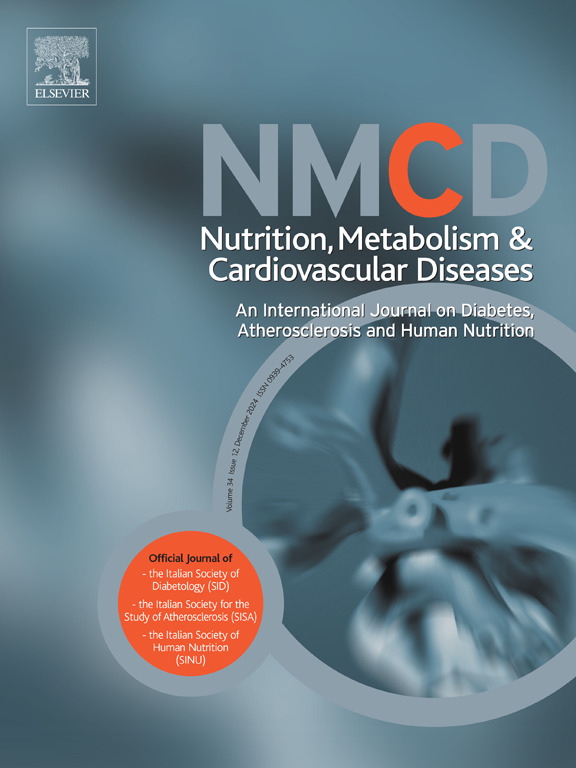Association of intra-individual differences in estimated GFR by creatinine versus cystatin C with incident cardiovascular disease
IF 3.7
3区 医学
Q2 CARDIAC & CARDIOVASCULAR SYSTEMS
Nutrition Metabolism and Cardiovascular Diseases
Pub Date : 2025-04-05
DOI:10.1016/j.numecd.2025.104034
引用次数: 0
Abstract
Background and aims
This study investigates the association between intra-individual differences in estimated glomerular filtration rate based on serum creatinine (eGFRscr) and cystatin C (ΔeGFRcysc-scr) and incident CVD.
Methods and results
This study used data from the China Health and Retirement Longitudinal Study (CHARLS) from 2015 to 2020. ΔeGFRcysc-scr were determined by subtracting eGFRscr from eGFRcysc. The outcome was the incidence of CVD, including heart diseases, and stroke, obtained through self-reports. Cox proportional hazard regression models were employed to examine the association between ΔeGFRcysc-scr and CVD risks. Restricted cubic spline with three knots at the 10th, 50th, and 90th centiles was conducted to flexibly model the association. During this period, 1187 incident CVD events were documented. After adjusting for covariates, the risk of CVD was reduced by 13.2 % (Hazard ratio [HR] = 0.868; 95 % confidence interval [95 % CI]: 0.818–0.921) for every 15 mL/min/1.73 m2 increase in baseline ΔeGFRcysc-scr. Specifically, individuals in negative-ΔeGFRcysc-scr group (<-15 mL/min/1.73 m2) had a 33.6 % increased risk of CVD events (HR = 1.336; 95 % CI: 1.151–1.551), and positive-ΔeGFRcysc-scr group (≥15 mL/min/1.73 m2) had a 34.5 % decrease risk of CVD events (HR = 0.655; 95 % CI: 0.541–0.794), compared with those in reference group (−15 to 15 mL/min/1.73 m2). These associations remained robust after adjusting for potential confounders or sensitivity analysis.
Conclusions
Our findings suggest that intra-individual differences in eGFR estimates based on creatinine versus cystatin C are associated with CVD risk in the Chinese population. This highlights the potential value of using both markers for more accurate CVD risk stratification in clinical practice.
肌酐与胱抑素C估算GFR的个体内差异与心血管疾病的关系
背景和目的:本研究探讨基于血清肌酐(eGFRscr)和胱抑素C (ΔeGFRcysc-scr)估算的肾小球滤过率的个体差异与心血管疾病发生率之间的关系。方法与结果:本研究使用了2015 - 2020年中国健康与退休纵向研究(CHARLS)的数据。ΔeGFRcysc-scr通过从eGFRcysc中减去eGFRscr来测定。结果是通过自我报告获得CVD(包括心脏病和中风)的发病率。采用Cox比例风险回归模型检验ΔeGFRcysc-scr与心血管疾病风险之间的关系。采用限制三次样条,分别在第10、第50、第90位处设置3个结点,以灵活地模拟这种关联。在此期间,记录了1187起CVD事件。调整协变量后,心血管疾病的风险降低了13.2%(风险比[HR] = 0.868;95%可信区间[95% CI]: 0.818-0.921),每增加15 mL/min/1.73 m2基线ΔeGFRcysc-scr。具体而言,-ΔeGFRcysc-scr阴性组(2)的个体CVD事件风险增加33.6% (HR = 1.336;95% CI: 1.151-1.551), -ΔeGFRcysc-scr阳性组(≥15 mL/min/1.73 m2)心血管事件风险降低34.5% (HR = 0.655;95% CI: 0.541-0.794),与对照组相比(-15 ~ 15 mL/min/1.73 m2)。在调整了潜在的混杂因素或敏感性分析后,这些关联仍然很强。结论:我们的研究结果表明,在中国人群中,基于肌酐和胱抑素C的eGFR估计值的个体差异与CVD风险相关。这突出了在临床实践中使用这两种标志物进行更准确的心血管疾病风险分层的潜在价值。
本文章由计算机程序翻译,如有差异,请以英文原文为准。
求助全文
约1分钟内获得全文
求助全文
来源期刊
CiteScore
6.80
自引率
2.60%
发文量
332
审稿时长
57 days
期刊介绍:
Nutrition, Metabolism & Cardiovascular Diseases is a forum designed to focus on the powerful interplay between nutritional and metabolic alterations, and cardiovascular disorders. It aims to be a highly qualified tool to help refine strategies against the nutrition-related epidemics of metabolic and cardiovascular diseases. By presenting original clinical and experimental findings, it introduces readers and authors into a rapidly developing area of clinical and preventive medicine, including also vascular biology. Of particular concern are the origins, the mechanisms and the means to prevent and control diabetes, atherosclerosis, hypertension, and other nutrition-related diseases.

 求助内容:
求助内容: 应助结果提醒方式:
应助结果提醒方式:


